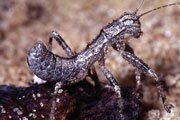For the first time in 87 years, researchers have discovered an insect that constitutes a new order of insects. Dubbed "the gladiator" (for the recent movie), it lives in the Brandberg Mountains of Namibia, on the west coast of Southern Africa.
Entomologist Oliver Zompro of the Max Planck Institute of Limnology in Plön, Germany, who identified the creature as unique, said it resembles "a cross between a stick insect, a mantid, and a grasshopper."
It differs from a stick insect, Zompro noted, because its first body segment is the largest. Unlike a mantid, it uses both its fore and mid legs to catch prey, and unlike a grasshopper, it can't jump.
Growing up to four centimeters (1.6 inches) long, "the gladiator" is carnivorous and nocturnal. It lives at the base of clumps of grass that grow in rock crevices.
Zompro first suspected that he was seeing a new insect order while examining fossils of stick-like insects sent to him by amber collectors in Germany. After finding similar specimens in more recent collections at museums in London and Berlin, he set out to determine whether the insect—which had been presumed extinct—might still be found in the wild.
The existence of the insect was confirmed last month on a field trip to Namibia.
The discovery of the new insect order, which has been named Mantophasmatodea, increases the number of insect orders to 31.
"This discovery is comparable to finding a mastodon or saber-toothed tiger," said Piotr Naskrecki, director of Conservation International's new Invertebrate Diversity Initiative.
Diana Wall, an ecologist at Colorado State University in Fort Collins, called the discovery "tremendously exciting" and said it could give scientists "a new perspective on how life fits together."
"This new order could be a missing link to determining relationships between insects and other groups," she said, adding: "Every textbook discussing the orders of insects will now need to be rewritten."
Lucky Break
No new order of insects has been identified since 1915. Zompro said he got lucky. "So many zoologists all over the world have combed the Earth for new specimens in so many locations that the chance of finding a new order is close to zero," he said. Zompro, a specialist in stick insects, was studying a group of fossils sent to him by various collectors when he began to suspect he was seeing a new type of insect. The oldest known specimen of the newly identified insect was encased in a 40-million-year-old chunk of golden amber. Over a period of six months, Zompro received nearly two dozen specimens that led him to conclude he had discovered a new order, but one that he thought was now extinct. One amber nugget contained a perfectly preserved adult specimen. Another fossil had captured the insect in the cannibalistic act of eating another.
"It's a big insect and difficult to overlook. That's what is so amazing" about the finding, Zompro said.
Sifting through entomology collections at the British Museum of Natural History in London, he found an adult male insect from Tanzania that looked remarkably like the specimens entombed in amber. A few weeks later, he came upon a female specimen of the insect at Berlin's Museum of Natural History. When Zompro dissected the specimen from the Berlin Museum, he found the remains of insects in its gut, indicating that the stick-like insect was a carnivore. All other known stick-like insects are plant eaters.
"At this point, I was sure that I had found an absolutely new order of insects," said Zompro.
Wilderness Search
Both of the insects Zompro observed in London and Berlin appeared related to the 40-million-year-old fossilized insect encased in amber. But the museum specimens had been collected during expeditions in the last century, suggesting that the insect was not extinct. Zompro photographed the three specimens and sent the pictures to museums in Africa and South America, requesting information about any insects that appeared to be similar. The National Museum of Namibia responded with a specimen that had been found in the Brandberg Mountains. It appeared to be from the same insect group. Eugene Marais, the museum's curator of entomology, met with Zompro in Berlin and examined the original amber fossil. Based on their analysis, Zompro made plans to travel to Namibia to search for the insect.
Earlier this month, he joined an expedition to the Brandberg Mountains, jointly sponsored by Conservation International, the Max Planck Institute, and the National Museum of Namibia. The team consisted of 16 entomologists from Germany, England, South Africa, Namibia, and the United States. The scientists were dropped onto a mountain peak in the remote area and began a painstaking search on the stony, arid summit. After a night of shaking grass bushes, a scientist looking for insects called silverfish found the first of the live insects that came to be known as "the gladiator." During the trip, Zompro collected a dozen of the insects, which he carried back to his lab in Germany to study mating, feeding, and other forms of behavior in the insects. Aggressive tendencies became one area of interest—a couple of the insects apparently were eaten during the the trip back. Zompro plans to return to Namibia to study the distribution of the insect in Namibia.
Naskrecki of Conservation International said Zompro's discovery is important because it "tells us that there are places on Earth that act as protective pockets, preserving tiny glimpses of what life was like millions of years ago." The Namibian insects, he added, "are one of the last living witnesses of a time when America and Africa were still part of the same land mass. This order was thought to be extinct for 35 to 50 million years."
